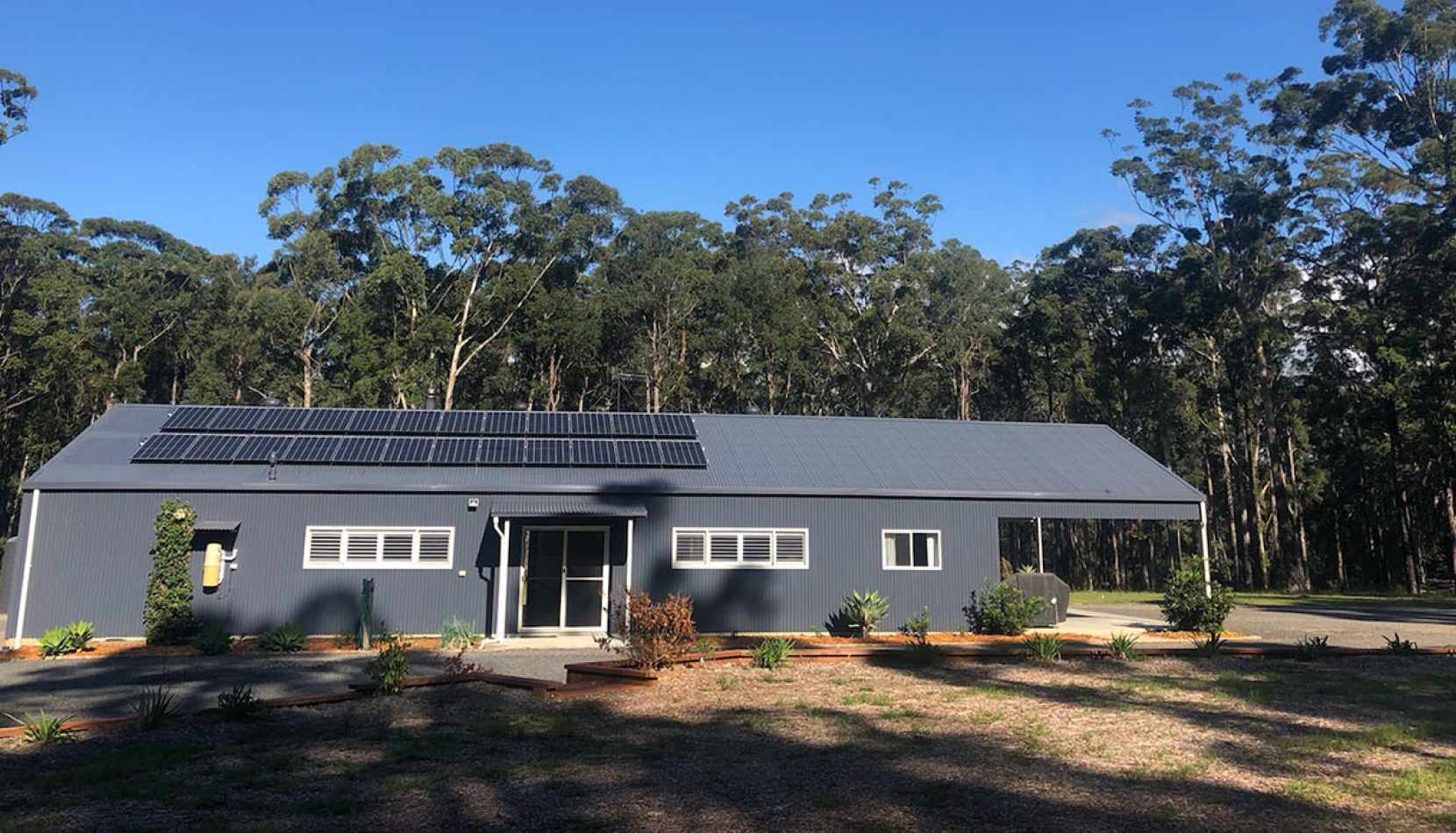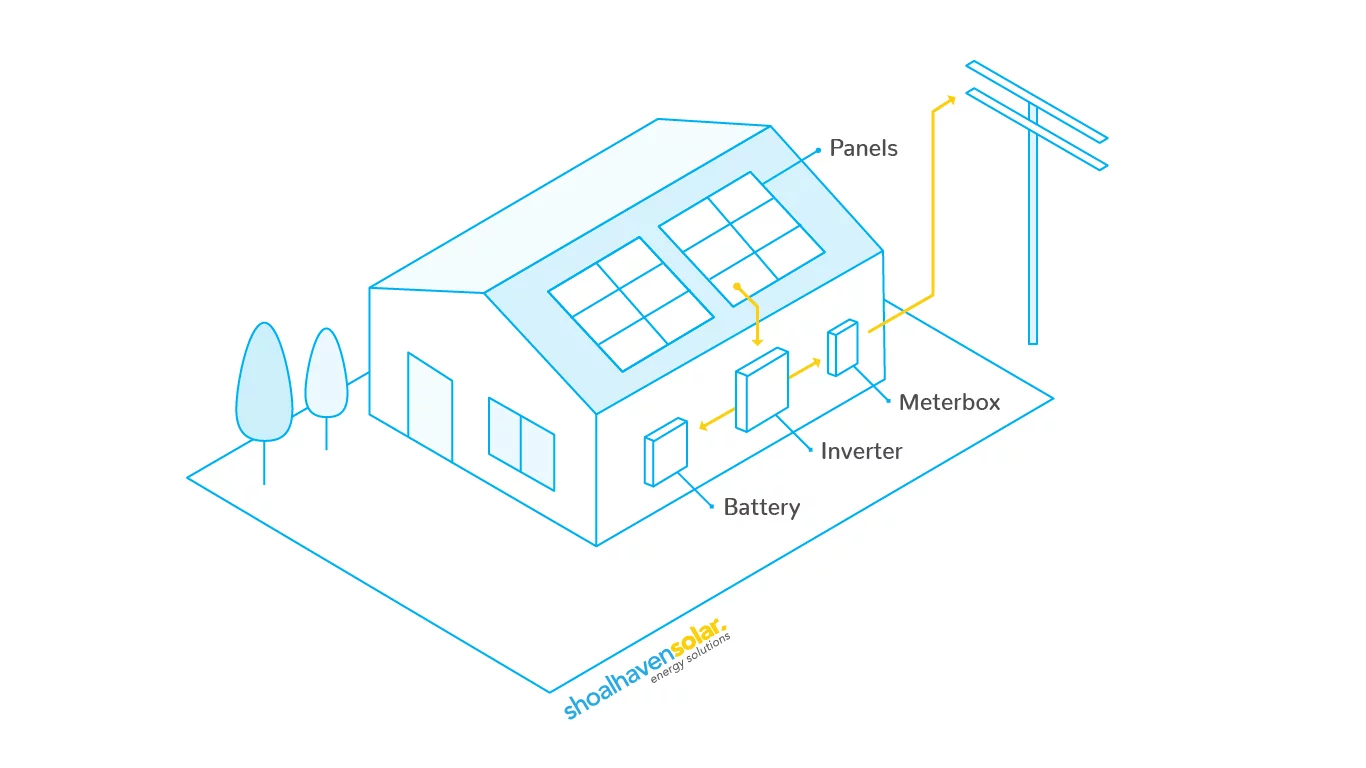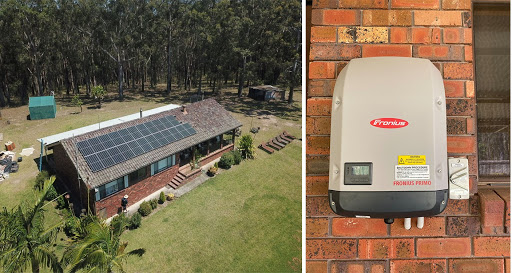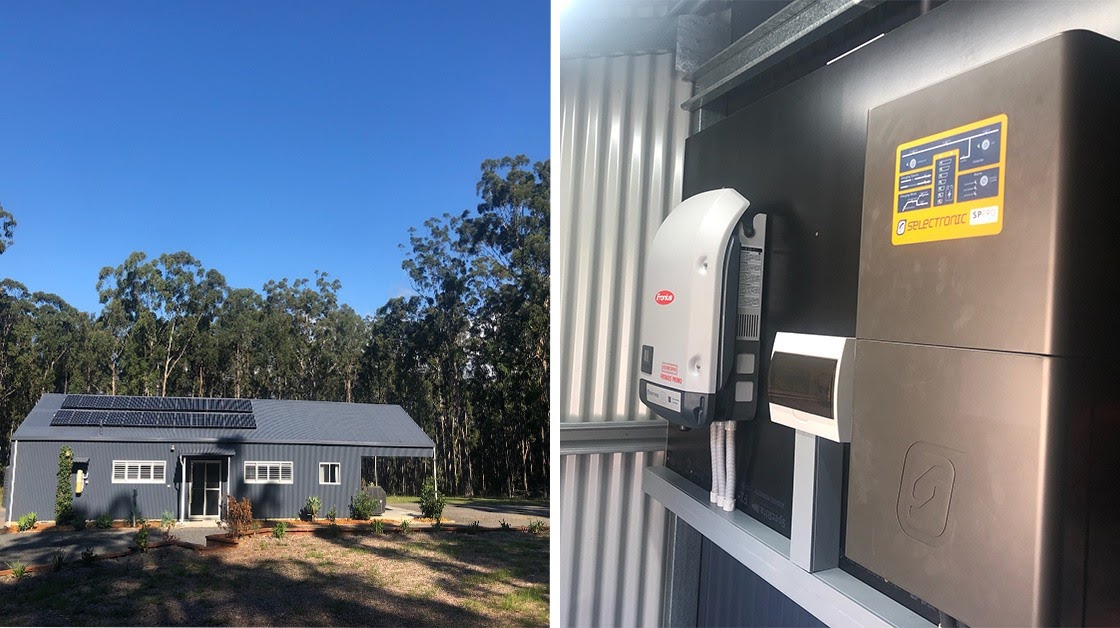- How Big Should Your Solar Battery and System Be?
- How solar battery storage works
- Introduction to solar battery storage
- Tesla Powerwall battery solutions
- What Do Solar Batteries Look Like – and Where Can I Install Them?
- What Size Solar System Should You Have When Adding a Battery
- What’s the Real ROI on Solar and Battery Systems in 2025?
- When are batteries worth it? Solar energy battery viability.
- Which Solar Battery Is Right for Your Home?
- Does Solar Increase Property Value in Shoalhaven? The Numbers Speak for Themselves
- Empowering Small Businesses with Solar: The Australian Small Business Energy Incentive
- How much will you save with solar?
- How the 2025 Australian Cheaper Home Batteries Program Works
- Solar finance options
- The 2024 NSW Government Home Solar Battery Rebate Scheme
- What government incentives and financing options are available for solar?

Going off-grid – solar power generation and storage systems
Are you looking to gain independent power to your home or business?
Off-grid, solar provides homeowners with the ability to live comfortably with a stand-alone power system, generating and storing your very own power from the sun.

Utilised by people living in remote or rural areas where the cost to connect to the grid is high or for anyone who would like to disconnect from the grid completely, off-grid solar systems are becoming more and more accessible due to the price and high-quality components.
What is an off-grid solar system?
An off-grid solar system is a stand-alone solar power system that provides electricity to a home or business independently from the grid. It is different from a standard residential solar power system in that there are specific components that apply to this type of system. Multi-mode inverters and adaptable batteries are the main difference. The beauty of an off-grid system is that the site is generating and storing its electricity from the sun, and the occupant/owner will not be receiving a quarterly power bill.
How does an off-grid solar system work?
Off-grid solar systems are generally made up of solar panels, a multi-mode inverter, and specially designed adaptable batteries.
The solar panels are placed in a sunny location on the building (usually the roof) and work to convert solar energy/sunlight into DC power using the multi-mode inverter. The DC power is then sent to the battery storage solution, where it stays until converted into AC power as needed, ready to power your home and appliances. Please refer to our diagram below:
What is the difference between on-grid and off grid solar systems?
The key difference between on and off-grid solar systems is the ability to store and use excess power without assistance from the grid. No electric bills!
On-grid system designs
An “on-grid” solar system is comprised of solar panels and the inverter. The energy that is generated by the system is used to power the home throughout the day, and any excess is fed back into the grid at the end of each day. The power that is fed back into the grid is then calculated, and a credit will be seen on your next electricity bill. This is called the Feed-In-Tariff.
For more information regarding the tariff and other ways that solar power can save you money, please read our article about it.
Feature | Included? |
|---|---|
Connected to the grid? | Y |
Ability to use solar power after dark? | N |
Battery storage included? | N |
Feed-In-Tariff credit? | Y |
Quarterly power bill? | Y |
Off-grid system designs
An off grid solar system includes solar panels, an inverter and a battery storage solution.
The power that’s generated by the system is used to power the home and appliances, with any leftover power stored in batteries to use during an evening or on a rainy day. This option doesn’t feature the feed-in tariff as the system is not connected to the grid in any way.
Feature | Included? |
|---|---|
Connected to the grid | N |
Ability to use solar power after dark | Y |
Battery storage included? | Y |
Feed-In-Tariff credit | N |
Quarterly power bill | N |
Who can benefit from an off-grid solar system?
Anyone living in a remote rural area or a rural area where the cost to connect to the grid is too high would benefit from an off-grid solar system, however, the option may appeal to anyone who’s looking to go green, avoid power outages and reduce electricity costs. This is applicable for both traditional homes and tiny homes/van home setups.
How to calculate the requirements for your off-grid solar system
When looking at off-grid solar power systems, it’s important to have a thorough understanding of your power requirements in order to be able to work out how much power you’ll need to be producing and storing in order to keep your home running.
In general, the goal is to create a battery bank that’s able to store enough power to supply your home for a few days in case of cloudy or rainy weather. Follow our easy steps below to work out how to size the batteries for your off-grid solar system.
Calculate the inverter size
Find your peak load or the maximum wattage of your home. This can be done by adding up the wattage of all the lights and appliances that could possibly be run at the same time. The sum will be an indication of which size inverter you should buy.
Daily use watt-hours/day
Find out how much energy is used each day. This can be done by adding up how long each device will be used/day. To find this, simply multiply the wattage of each device by the hours it will be used each day, and then add those figures together. The final amount you estimate is likely to be too low due to efficiency loss, so multiply the figure by 1.5 to account for decreasing performance with temperature increases.
Days of storage
Decide how many days of backup power you want. Once you have the figure for your daily usage, it’s time to decide how many days of reserve power you want to have on hand and stored in your batteries. Most people opt for between 2 and 5 days.
Battery bank capacity
Calculate the minimum battery AH Capacity. To do this take the watts/day figure and multiply it by the number of days of backup storage you want to have. Take the figure that you have, multiply it by 2, then divide that figure by the battery voltage to convert the KWH result into amp hours (AH).
Complete off-grid solar system kits
If you’re looking at going off-grid, it’s often easiest to invest in a solar system kit. Off-grid solar kits come in a range of sizes and options, we’ve listed some common sizes below for your convenience:
4.95 kW – Best suited to a low energy/small household that uses approx 10-15 KWH per day.
6.6 kW – Best suited to a couple or an energy-conscious family of 4 whose power usage is approx 15-25 KWH per day.
8.68 kW – Best suited to a household that uses approx 25-35 KWH per day
12.97 kW – Best suited to power large family homes of 5+ people using approx 35-45 KWH per day.
If you’re unsure which would be best suited to you and your needs, you can calculate your system size needs here or give our team a call for a free site visit and quote.

Complete off-grid solar installation
Installation for off-grid solar systems has become easier and more cost-effective in the last few years thanks to advances in technology and a decrease in battery prices.
Installation is usually included in the package price when you purchase a solar package from a reputable solar specialist such as Shoalhaven Solar.
Installation time for an off-grid solar system varies between 1-2 days, depending on the exact nature of the setup and property.
How much does an off-grid solar system cost?
Off-grid solar systems can range in cost, depending on which brands, products and companies you decide to go through.
Here at Shoalhaven Solar, we pride ourselves on using high-quality products that have lengthy warranties and great customer support. You may pay a little more initially, but the quality and lifetime performance of the products are much better than what some retailers are currently using.
Off-grid solar system price Australia
Our off-grid solar systems start at $19,000. For a personalised quote please get in touch to organise a free site visit and quote.
